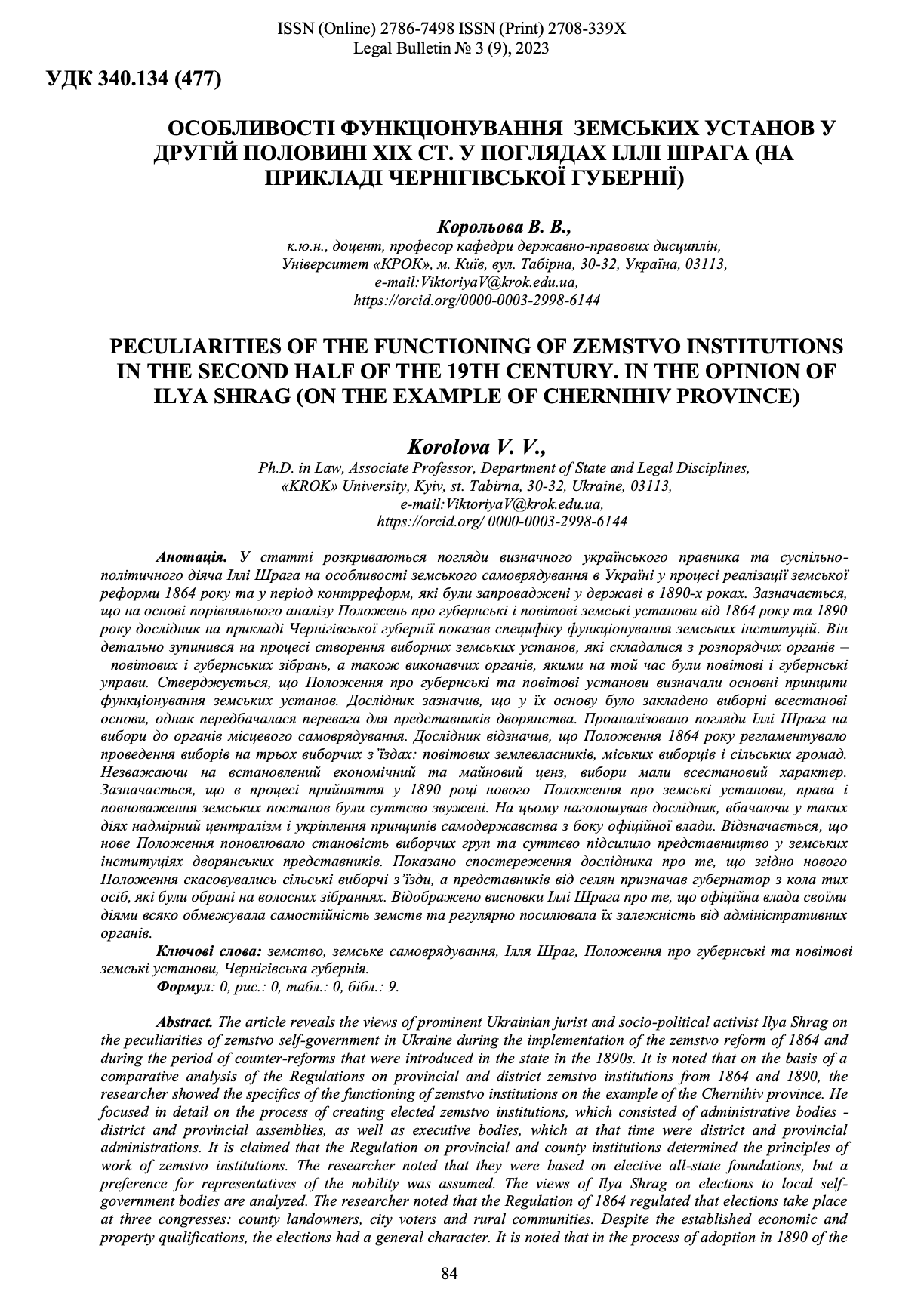Peculiarities of the functioning of zemstvo institutions in the second half of the 19th century. in the opinion of Ilya Shrag (on the example of Chernihiv province)
DOI:
https://doi.org/10.31732/2708-339X-2023-09-84-89Keywords:
zemstvo, zemstvo self-government, Ilya Shrag, Regulations on provincial and district zemstvo institutions, Chernihiv province.Abstract
The article reveals the views of prominent Ukrainian jurist and socio-political activist Ilya Shrag on the peculiarities of zemstvo self-government in Ukraine during the implementation of the zemstvo reform of 1864 and during the period of counter-reforms that were introduced in the state in the 1890s. It is noted that on the basis of a comparative analysis of the Regulations on provincial and district zemstvo institutions from 1864 and 1890, the researcher showed the specifics of the functioning of zemstvo institutions on the example of the Chernihiv province. He focused in detail on the process of creating elected zemstvo institutions, which consisted of administrative bodies - district and provincial assemblies, as well as executive bodies, which at that time were district and provincial administrations. It is claimed that the Regulation on provincial and county institutions determined the principles of work of zemstvo institutions. The researcher noted that they were based on elective all-state foundations, but a preference for representatives of the nobility was assumed. The views of Ilya Shrag on elections to local self-government bodies are analyzed. The researcher noted that the Regulation of 1864 regulated that elections take place at three congresses: county landowners, city voters and rural communities. Despite the established economic and property qualifications, the elections had a general character. It is noted that in the process of adoption in 1890 of the new Regulations on Zemstvo Institutions, the rights and powers of Zemstvo Resolutions were significantly narrowed. The researcher emphasized this, seeing in such actions excessive centralism and strengthening of the principles of autocracy on the part of the official authorities.It is noted that the new Regulation renewed the status of electoral groups and significantly strengthened the representation of noble representatives in zemstvo institutions. The researcher's observation is shown that according to the new Regulation, village electoral congresses were abolished, and representatives from the villagers were appointed by the governor from among those persons who were elected at the parish meetings. The conclusions of Ilya Shrag are reflected that the official authorities limited the independence of zemstvos by their actions and regularly increased their dependence on administrative bodies.
References
Білокінь М. В. Земське самоврядування і державна влада у російській імперії. Вісник Національного університету внутрішніх справ. 2002. Вип. 17. С.185-190.
Макієнко О. А. Організація служби діловодства в земських управах на території України (друга половина ХІХ – початок ХХ ст.). Історичний архів. Наукові студії. Миколаїв, 2010. Вип. 5. С. 18-22.
Гончаренко В. Д. Органи земського самоврядування в Україні у другій половині XIX – на початку XX ст. Державне будівництво та місцеве самоврядування. Х.: Право, 2003. Вип. 6. С. 139-152.
Демченко Т. Батько Шраг: монографія. Чернігів : Десн. правда, 2008. 264 с.
Хижняков В. М. Чернігівська старовина. Чернігів: Десна Поліграф, 2016. 352 с.
Рахно О. Земська реформа 1864 р. і утворення органів земського самоврядування в Чернігівській губернії. Сiверянський лiтопис. 2010. № 6. С. 101-111.
Шраг І. Лист ІІІ. І. Л. Шраг. Документи і матеріали / упор. В. М. Шевченко, Т.П. Демченко, В. І. Онищенко. Чернігів, 1997. С. 71-82.

Downloads
Published
How to Cite
Issue
Section
License
Copyright (c) 2023 В.В. Корольова

This work is licensed under a Creative Commons Attribution 4.0 International License.




